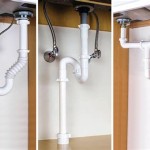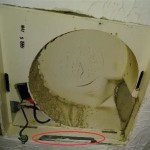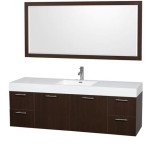How to Measure for a Bathroom Faucet
Selecting a new bathroom faucet can significantly enhance the aesthetics and functionality of a bathroom. However, before making a purchase, accurate measurements are crucial to ensure the new faucet is compatible with the existing sink and plumbing configuration. Proper measurements prevent costly errors and ensure a smooth installation process. This article provides a comprehensive guide to measuring for a bathroom faucet, covering essential aspects like faucet hole configuration, spout reach, faucet height, and clearance considerations.
Understanding Faucet Hole Configurations
The first step in measuring for a new bathroom faucet involves identifying the existing hole configuration in the sink or countertop. Bathroom sinks typically feature one of three standard hole configurations: single-hole, centerset, or widespread. Each configuration requires a specific type of faucet. Identifying the correct configuration is paramount to ensuring a proper fit and preventing the need for additional modifications to the sink or countertop.
Single-Hole Faucets: Single-hole faucets are designed for sinks with only one pre-drilled hole. These faucets typically feature a single handle for controlling both water temperature and flow. Measuring for a single-hole faucet is relatively straightforward. The primary measurement required is the diameter of the existing hole. This measurement ensures that the faucet base can properly cover the hole without any gaps. Standard hole diameters for single-hole faucets are typically 1 3/8 inches (3.5 cm), but it is always advisable to confirm the specific measurement.
Centerset Faucets: Centerset faucets are designed for sinks with three holes that are typically 4 inches apart. The spout and handles are mounted on a single base unit. To measure for a centerset faucet, measure the distance between the centers of the outermost holes. This distance is referred to as the "spread." If the spread measures 4 inches, a standard centerset faucet will likely be suitable. Additionally, measure the diameter of each hole to ensure compatibility with the faucet's mounting hardware. Standard hole diameters are usually around 1 3/8 inches (3.5 cm).
Widespread Faucets: Widespread faucets are designed for sinks with three holes where the distance between the outermost holes is typically 8 inches or greater, allowing for greater flexibility in handle placement. The spout and handles are separate pieces, providing a more customizable aesthetic. Measuring for a widespread faucet involves measuring the distance between the centers of the outermost holes, similar to a centerset faucet. However, with widespread faucets, this distance can vary, typically ranging from 8 to 16 inches. Ensure the chosen faucet's handle spread is adjustable to match the sink's hole configuration. Again, measure the diameter of each hole to confirm compatibility with the mounting hardware.
When measuring hole configurations, it is important to use a measuring tape or ruler and record the measurements accurately. Double-checking the measurements can prevent errors and ensure that the new faucet is compatible with the sink.
Determining Spout Reach and Height
Beyond the hole configuration, the spout reach and height are critical measurements that impact the usability and appearance of the faucet. Spout reach refers to the horizontal distance from the base of the faucet to the point where the water stream exits the spout. Spout height refers to the vertical distance from the base of the faucet to the highest point of the spout.
Spout Reach: The ideal spout reach depends on the size and shape of the sink. A spout that is too short may cause the water to hit the back of the sink, leading to splashing and potential damage to the countertop. Conversely, a spout that is too long may cause the water to stream too far forward, making it difficult to reach. To determine the appropriate spout reach, measure from the center of the faucet hole (or the anticipated center if no faucet is currently installed) to the center of the sink bowl. This measurement provides a baseline for selecting a faucet with a suitable reach. Consider the depth of the sink as well. A deeper sink may require a longer spout reach to ensure the water stream reaches the center of the bowl.
Spout Height: Spout height impacts both the aesthetics and functionality of the faucet. A taller spout provides more clearance for washing hands and filling containers. However, a spout that is too tall may appear disproportionate to the sink and surrounding fixtures. To determine the appropriate spout height, consider the intended use of the sink. If the sink will be used primarily for handwashing, a shorter spout may be sufficient. If the sink will be used for filling larger containers, a taller spout is recommended. Also consider the distance between the spout outlet and the sink bottom. There should be enough clearance, usually more than 4 inches, for practical use. Also, consider the overall aesthetic of the bathroom when selecting a spout height. A taller spout can create a more modern and dramatic look, while a shorter spout can create a more traditional and understated look.
When considering spout reach and height, it is also important to account for any obstructions that may be present, such as soap dispensers or other fixtures. These obstructions may limit the available space and necessitate adjustments to the spout reach or height.
Considering Clearance and Plumbing Connections
In addition to hole configuration, spout reach, and spout height, it is important to consider clearance and plumbing connections when measuring for a bathroom faucet. Clearance refers to the amount of space available around the faucet for installation and maintenance. Plumbing connections refer to the type and size of the water supply lines that connect the faucet to the water supply.
Clearance: Sufficient clearance is essential for installing and maintaining the faucet. Check the specifications of each potential faucet to determine its minimum clearance requirements, then access the location under the sink where the faucet will be installed. Ensure there is adequate space for the faucet body, handles, and supply lines. Limited clearance can make installation difficult or impossible. When evaluating clearance, also consider the position of the drain assembly. Ensure that the faucet does not interfere with the drain assembly's operation. If the sink is located near a wall or other obstruction, measure the distance between the faucet and the obstruction to ensure there is sufficient space for the faucet to operate freely.
Plumbing Connections: Bathroom faucets connect to the water supply via flexible supply lines. These lines typically have a standard connection size of 3/8 inch or 1/2 inch. Prior to purchasing a new faucet, inspect the existing plumbing connections to determine the correct size. If the existing supply lines are not compatible with the new faucet, adapters may be required. It is also important to consider the length of the supply lines. Ensure that the supply lines are long enough to reach the faucet connections without being stretched or strained. If the existing supply lines are too short, they may need to be replaced. Consider the shut-off valves, if the shut-off valves are corroded or malfunctioning, they should be replaced during the faucet installation. Replacing the shut-off valves can prevent future leaks and make it easier to perform maintenance in the future.
When considering clearance and plumbing connections, it is advisable to consult with a professional plumber. A plumber can evaluate the existing plumbing system and provide recommendations for ensuring a smooth and successful faucet installation.
Accurate measurements are foundational to the successful installation of a bathroom faucet. By carefully considering the hole configuration, spout reach, spout height, clearance, and plumbing connections, individuals can select a faucet that is not only aesthetically pleasing but also functional and compatible with their existing bathroom setup. Taking the time to properly measure for a bathroom faucet can save time, money, and frustration in the long run. This process empowers individuals to make informed decisions and create a bathroom space that meets their specific needs and preferences.

How To Measure A Bathroom Faucet The Home Depot

How To Measure A Bathroom Faucet The Home Depot

How To Measure A Bathroom Faucet The Home Depot

How To Measure A Bathroom Faucet The Home Depot

Bathroom Layout Measurement Advice Victoriaplum Com More
How To Choose A New Bathroom Sink Faucet Vevano

How To Measure A Bathroom Faucet The Home Depot

How To Measure A Bathroom Faucet The Home Depot

How To Measure A Bathroom Sink Size Lavatory For Replacement
How To Measure For A Bathroom Basin Or Sink Victoriaplum Com
Related Posts







